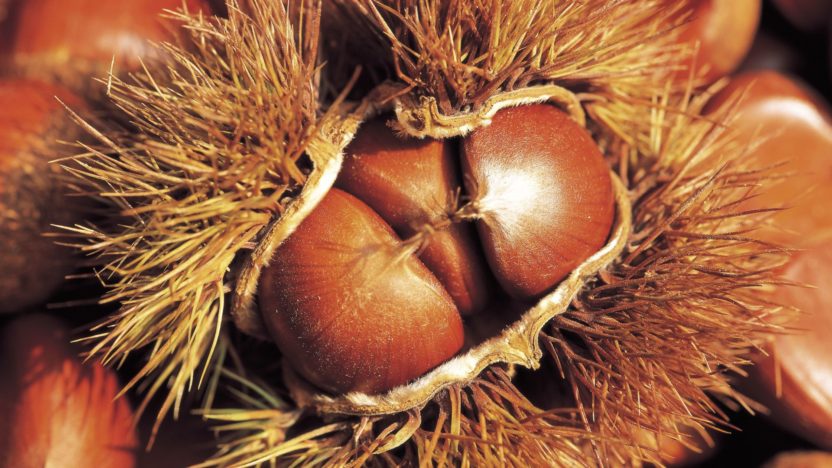 DOP
Toscana
DOP
Toscana
Brown by Caprese Michelangelo
The Brown of Caprese Michelangelo is a Designation of Protected Origin (DOP) on the national list approved by the Ministry of Agriculture And Forestry, whose requirements are regulated by the production discipline of the Region Tuscany.
Features
The Dop Brown by Caprese Michelangelo is reserved exclusively for fresh and dry fruits of the species Castanea sativa Mill.
For the production of Caprese Michelangelo’s Brown, the fruits of the local ecotype “Marrone di Caprese Michelangelo” are used, due to the “Marrone” variety, to be used for fresh and dry consumption.
The carpological characteristics for the consumption of fresh chestnut are as follows:
– fruits: Havana-colored skin with brown streaks, more or less intense;
– form: tending to elliptical–rounded or, in the central fruit, tend to square;
– pulp: ivory white color not engraved with the episperma (thin skin that covers it), characterized by slight scented notes of almond and vanilla.
The consumption characteristics of dried chestnut should be as follows:
– appearance of fruits: healthy, healthy, with no more than 5% of deformed fruits or with traces of blazing or mold;
– color: ivory or light straw.
Cooking as a roaster, intensifies the characteristics of perfume and makes the pulp pleasantly crumbly and mushy.
Boiled fruits have a more delicate taste than ‘roasted hotness’, more sugary for partial depolymerization of starch.
Cultivation
The culture technique involves the preparation of the soil before harvesting, which must be carried out exclusively by mechanical means.
The density of the plants in production must not exceed 120 plants per hectare. In order to ensure effective pollination in the plants can be present up to a maximum of 10% other varieties.
Harvesting is allowed from 20 September, excluding the use of the wand or other mechanical and/or chemical means that anticipate or accelerate the detachment from the tree.
It is allowed to use mechanical racketing, the gaiting of hedgehogs with special machines, the mechanical typing of the peglia (i.e. small hedgehogs), the garbage of the leaves with mechanical fans.
However, such interventions should not damage the product’s characteristics.
Sorting is done to eliminate fruits that are left to pathogens or other factors. The sorting is done manually. The maximum percentage of fruits that do not meet the above characteristics must not exceed 5% of the weight.
The calibration is done exclusively on the “Brown” variety. The same can be performed even before sorting and possible care. It can also be carried out with special calibrative machines.
The number of fruits must not exceed 90 units per kg.
The product that does not have the characteristics established by this disciplinary to be intended for fresh consumption, can be used for production in dry chestnut.
The care of the fruits serves to maintain the serbability of the product and is not mandatory. If the same is carried out, it must be carried out exclusively by water, both cold with immersion in water at room temperature for a period of 5 to 9 days; both hot, consisting of immersing the fruits in hot water at 48 degrees Celsius for 50′ and then kept in cold water for another 50′. This process does not damage the typical characteristics of the product.
The use of chemical additives is not permitted under any circumstances.
For consumption in the fresh state of the “Brown of Caprese Michelangelo” are allowed only the fruits of the variety “Marrone”.
For the production of dried chestnuts “Marrone di Caprese Michelangelo” is allowed the use of the fruits of the variety “Marrone”.
This product is obtained by drying and then peeling the fruits.
Drying is carried out using the traditional technique of wood drying, or using hot air dryers.
Traditional dryers are constructions, single-camera, located both in chestnut trees and near houses.
In them internally is prepared, a horizontal lattice built with chestnut posts, on which is laid a minimum layer of 30 cm of chestnuts.
A “dead” fire is kept on the floor of the dryer, i.e. without flames.
The drying is completed within 40 days, starting from the moment the chestnuts are put on the gratings, depending on the achievement of the typical characteristics of the dried chestnut “Brown of Caprese Michelangelo”.
Drying can also be carried out by hot air dryers, operating with appropriately varied temperatures during drying and between 25 and 45 degrees Celsius. The right degree of drying is obtained within a maximum of 15 days from the placing of chestnuts in the dryer.
Peeling machines are used for peeling.
It is a well-established use from ancient times to package together the dried product of the two varieties.
The conditioning of the peeled fruits used for consumption in the dried state is the same as for unpeeled fruits intended for fresh consumption.
The product is harvested fresh and still with the presence of hedgehogs, the high humidity in the massed fruits could generate heating phenomena with the onset of mold, rotting or unpleasant odors with strong impairments of the qualities of the product that therefore, it must be conditioned in a short time.
History and curiosity
The Brown by Caprese Michelangelo represents the historical denomination that is identified with a typical crop of the territory documented, among other things, from historical sources dating back to the 12th century, such as: notary rogiti related to buy-to-let and transmissions hereditary chestnuts, specific rules contained in the “Statutes of Caprese of 1386”, from the existence of monumental specimens of chestnut grafted with an estimated age over 500-600 years.
The chestnuts “capresani” cover the entire side of the Alpe di Catenaia in a uniform way. The local community was from a continuous generation of a phenomenon of “forest population” that began in the 9th and X centuries, during the rule of the Arimanni, to which they had been assigned in enjoyment lands of strategic interest. Since then the long process of transformation that has changed the wild chestnut to domestic chestnut with the introduction of graft. Since that time chestnut care has represented the primary commitment of every family, a condition of 84% of the population of Caprese already in the first decades of the ‘400.
Subsequently the cultivation of chestnut trees instituted strict forms of protection of chestnut. No one was allowed to cut and remove timber unless with the permission of all councillors and the harvest was also regulated by local rules.
The varieties, which we find today in the chestnut trees of the range, are ecotypes evolved over time through a centuries-old careful selection (definable “massale”) of propagation material taken from the most representative and best specimens
From an agronomic and pomological point of view, more suitable for environmental characteristics.
Chestnut has been deeply embedded in the local culture for centuries, both for the preparation of numerous dishes typical of Goresana cuisine (over 20 are chestnut dishes and sweets), and for the existence of nursery rhymes and folk songs inherent in the chestnuts, both for the many specific vocabulary and locutions of the local vernacular.
The homogeneity, the typical and peculiarity of the product are also determined by particular pedoclimatic factors. The territory consists of brown, brown and brown-liscied soils, usually with absent or very scarce carbonates, and therefore acidic or acidic divers. The climate is typical sub-continental, with average harsh winters and mild summers with rainfall hovering around 800 mm per year.
The peculiar feature of Caprese Michelangelo’s Brown is the presence in itself of a high amount of starch, due to the substantial water reserves of which the soils on which the fruit chestnuts are present.
Other elements that determine the accumulation of starch are the particular exposure of chestnuts, which allows to enjoy solar energy from the early hours of the morning with the benefit of a faster elimination of any summer wrinkles, the geomorphility and altitude that also favor frequent moderate ventings. The optimization of the hair lighting is achieved thanks to the low plantation density and the pruning pruning. All these factors combined together give the product typical morphological and sensory characteristics that make it extremely appreciated and easily recognizable.


